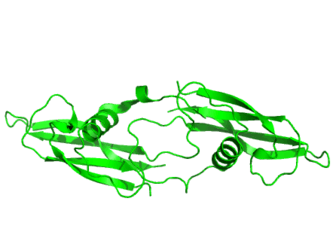Artemin
Artemin, also known as enovin or neublastin, is a protein that in humans is encoded by the ARTN gene.[2][3]
Function
Artemin is a neurotrophin in the glial cell line-derived neurotrophic factor (GDNF ) family of ligands which are a group of ligands within the TGF-beta superfamily of signaling molecules. GDNFs are unique in having neurotrophic properties and have potential use for gene therapy in neurodegenerative disease. Artemin has been shown in culture to support the survival of a number of peripheral neuron populations and at least one population of dopaminergic CNS neurons. Its role in the PNS and CNS is further substantiated by its expression pattern in the proximity of these neurons. This protein is a ligand for the RET receptor and uses GFR-alpha 3 as a coreceptor.[2]
References
- ↑ PDB 2GYR;Wang X, Baloh, RH, Milbrandt J, Garcia KC (June 2006). "Structure of artemin complexed with its receptor GFRalpha3: convergent recognition of glial cell line-derived neurotrophic factors". Structure 14 (6): 1083–1092. doi:10.1016/j.str.2006.05.010. PMID 16765900. ; rendered using PyMOL
- ↑ 2.0 2.1 "Entrez Gene: artemin".
- ↑ Baloh RH, Tansey MG, Lampe PA, Fahrner TJ, Enomoto H, Simburger KS et al. (Dec 1998). "Artemin, a novel member of the GDNF ligand family, supports peripheral and central neurons and signals through the GFRalpha3-RET receptor complex". Neuron 21 (6): 1291–302. doi:10.1016/S0896-6273(00)80649-2. PMID 9883723.
Further reading
- Rosenblad C, Grønborg M, Hansen C, Blom N, Meyer M, Johansen J et al. (Feb 2000). "In vivo protection of nigral dopamine neurons by lentiviral gene transfer of the novel GDNF-family member neublastin/artemin". Molecular and Cellular Neurosciences 15 (2): 199–214. doi:10.1006/mcne.1999.0817. PMID 10673327.
- Zhu DL, Luo DL, Luo G, Wang B, Gao JM (Mar 2009). "[Artemin and GFRalpha3 expressions and their relevance to perineural invasiveness and metastasis of pancreatic carcinoma]". Nan Fang Yi Ke Da Xue Xue Bao = Journal of Southern Medical University 29 (3): 428–32. PMID 19304517.
- Silvian L, Jin P, Carmillo P, Boriack-Sjodin PA, Pelletier C, Rushe M et al. (Jun 2006). "Artemin crystal structure reveals insights into heparan sulfate binding". Biochemistry 45 (22): 6801–12. doi:10.1021/bi060035x. PMID 16734417.
- Pandey V, Qian PX, Kang J, Perry JK, Mitchell MD, Yin Z et al. (Mar 2010). "Artemin stimulates oncogenicity and invasiveness of human endometrial carcinoma cells". Endocrinology 151 (3): 909–20. doi:10.1210/en.2009-0979. PMID 20118197.
- Masure S, Geerts H, Cik M, Hoefnagel E, Van Den Kieboom G, Tuytelaars A et al. (Dec 1999). "Enovin, a member of the glial cell-line-derived neurotrophic factor (GDNF) family with growth promoting activity on neuronal cells. Existence and tissue-specific expression of different splice variants". European Journal of Biochemistry / FEBS 266 (3): 892–902. doi:10.1046/j.1432-1327.1999.00925.x. PMID 10583383.
- Fernandez RM, Ruiz-Ferrer M, Lopez-Alonso M, Antiñolo G, Borrego S (Nov 2008). "Polymorphisms in the genes encoding the 4 RET ligands, GDNF, NTN, ARTN, PSPN, and susceptibility to Hirschsprung disease". Journal of Pediatric Surgery 43 (11): 2042–7. doi:10.1016/j.jpedsurg.2008.05.018. PMID 18970938.
- Ceyhan GO, Schäfer KH, Kerscher AG, Rauch U, Demir IE, Kadihasanoglu M et al. (May 2010). "Nerve growth factor and artemin are paracrine mediators of pancreatic neuropathy in pancreatic adenocarcinoma". Annals of Surgery 251 (5): 923–31. doi:10.1097/SLA.0b013e3181d974d4. PMID 20395845.
- Kang J, Perry JK, Pandey V, Fielder GC, Mei B, Qian PX et al. (May 2009). "Artemin is oncogenic for human mammary carcinoma cells". Oncogene 28 (19): 2034–45. doi:10.1038/onc.2009.66. PMID 19363524.
- Wang X, Baloh RH, Milbrandt J, Garcia KC (Jun 2006). "Structure of artemin complexed with its receptor GFRalpha3: convergent recognition of glial cell line-derived neurotrophic factors". Structure 14 (6): 1083–92. doi:10.1016/j.str.2006.05.010. PMID 16765900.
- Quartu M, Serra MP, Manca A, Mascia F, Follesa P, Del Fiacco M (Apr 2005). "Neurturin, persephin, and artemin in the human pre- and full-term newborn and adult hippocampus and fascia dentata". Brain Research 1041 (2): 157–66. doi:10.1016/j.brainres.2005.02.007. PMID 15829225.
- Otsuki K, Uchida S, Watanuki T, Wakabayashi Y, Fujimoto M, Matsubara T et al. (Oct 2008). "Altered expression of neurotrophic factors in patients with major depression". Journal of Psychiatric Research 42 (14): 1145–53. doi:10.1016/j.jpsychires.2008.01.010. PMID 18313696.
- Naveilhan P, Baudet C, Mikaels A, Shen L, Westphal H, Ernfors P (Feb 1998). "Expression and regulation of GFRalpha3, a glial cell line-derived neurotrophic factor family receptor". Proceedings of the National Academy of Sciences of the United States of America 95 (3): 1295–300. doi:10.1073/pnas.95.3.1295. PMC 18749. PMID 9448325.
External links
This article incorporates text from the United States National Library of Medicine, which is in the public domain.
PDB gallery |
|---|
| | 2gh0: Growth factor/receptor complex |
| 2gyr: Crystal structure of human artemin |
| 2ask: Structure of human Artemin |
| 2gyz: Crystal structure of human artemin |
|
|
|
|
|---|
| | Trk binding | |
|---|
| | GFL | |
|---|
| | Other | |
|---|
| |
|---|
| | Description |
- Anatomy
- Nerves
- cranial
- trigeminal
- cervical
- brachial
- lumbosacral plexus
- somatosensory
- spinal
- autonomic
- Physiology
- reflexes
- proteins
- neurotransmitters
- transporters
- Development
|
|---|
| | Disease |
- Autonomic
- Congenital
- Injury
- Neoplasms and cancer
- Other
- Symptoms and signs
|
|---|
| | Treatment |
- Procedures
- Local anesthetics
|
|---|
|
|
|
|---|
| | CNTF | |
|---|
| | LNGF | |
|---|
| | RET | |
|---|
| | Trk | TrkA | |
|---|
| TrkB |
- Agonists: 3,7-DHF
- 3,7,8,2'-THF
- 4'-DMA-7,8-DHF
- 5,7,8-THF
- 7,3'-DHF
- 7,8-DHF
- 7,8,2'-THF
- 7,8,3'-THF
- Amitriptyline
- BDNF
- Deoxygedunin
- Diosmetin
- HIOC
- LM-22A4
- N-Acetylserotonin
- NT-3
- NT-4
- TDP6
- Antagonists: 3,5,7,8,3',4'-HHF
- ANA-12
- Cyclotraxin B
|
|---|
| TrkC | |
|---|
|
|---|
|




